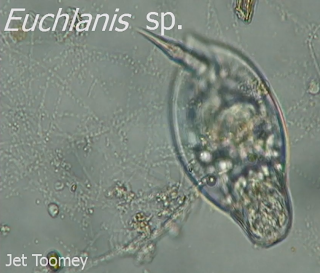I revisited my MicroAquarium™ on 11/06/2013. I was able to spend a great deal of time analyzing my MicroAquarium™ with the compound light microscope and recording my findings with digital video equipment. This was the most "active" viewing period experienced so far. I feel this was due to a combination of the added food source and my growing competence with the microscope and digital recording equipment. I was able to spot life in almost every area of my MicroAquarium™. I was also able to see small organisms darting through the water without the aide of magnification.
Figure 1: Photo of Euchlanis sp. captured during
movement while feeding in an open area of the
MicroAquarium™ (Pennak, 1953)
I viewed many of these larger organisms and identified them as Euchlanis sp. (Pennak, 1953) After researching this organism I can confidently say that it is the adult form of the unknown organism I documented in Week 2. I learned Euchlanis is the genus for all rotifers. (Pennak, 1953) These organisms appeared more complex than most of their peers. They had two "tails" on their posterior that they often pulled together so that it looked like one large structure. (as seen in Figure 1) Many different organs were visible through their transparent bodies. One feature unique with rotifers are a circle of cilia at their anterior end which create a current that is used to funnel food into their mouths. (Davidson, 1998) Once the food enters their mouth it's crushed by an anatomical device called a mastax which is basically a spiked pharynx from hell. I watched the Euchlanis sp. consume anything within proximity that was able to physically fit into their mouths. (as seen in Video 2) They appeared in greater numbers around vegetation such as Fontinalis sp. (Mcfarland, 2013) The appetite of the Euchlanis sp. is insatiable; I found one with both of its "tails" wedged tightly in branching vegetation and it continued to eat everything around it while being minimally phased by its presumable death sentence. (as seen in Video 3)
Video 1: Footage of Euchlanis sp. consuming debris and
moving rapidly in an open area of the MicroAquarium™
(Pennak, 1953)
Video 2: Footage of Euchlanis sp. feeding on and around
the vegetation Fontinalis sp. (Pennak, 1953)
Video 3: Footage of Euchlanis sp. stuck on the vegetation
Fontinalis sp. but still taking time to consume particles
and debris within its proximity. (Pennak, 1953)
Another interesting organism I found and later identified was the Difflugia sp. (Patterson, 1996) This organism belongs to a major group of amoeboid protozoa in the kingdom protista. Most of the time these organisms are found to be heterotrophs and use pseudopods to move around and capture prey.
Figure 2: Photo of Difflugia sp. (Patterson, 1996) Note the
silica like outer shell and irregular shape.
If you look closely at the included footage you can see the near transparent pseudopods used to push and pull the organism in different directions. What makes this amoeboid so interesting (in my humble opinion) is how it builds its exterior shell. When I first spotted this organism I honestly thought it was some bizarre or damaged diatom. This was due to what looked like a hard silica shell-like outer layer. It wasn't organized and symmetrical like the diatoms I'd previously documented, instead the outer shell was chaotic and random. I learned that this outer shell is created by the Difflugia sp. using particles gained from its environment or prey. (Patterson, 1996) For example, they consume diatoms and use the silica particles for their shell. This type of shell is referred to as being agglutinate. Amazingly, many Difflugia select particles of certain size and shape and construct a species specific shell. That blows my mind.
Video 4: Footage of Difflugia sp. using pseudopods to
grab and pull itself to a piece of debris. (Patterson, 1996)
Video 5: Additional footage of Difflugia sp. using
pseudopods near debris. (Patterson, 1996)
That's all for now. I will be spending more time observing my MicroAquarium™ this week, so stay tuned for another update. I recently checked my hit counter for this blog and was extremely disappointed. I was expecting hundreds of thousands, if not millions of unique visitors per day and the reality of the data hit me like a ton of bricks; seven unique visitors and 120+ total hits. After days of deep depression I've come to terms with my popularity (or lack thereof) and decided that blog views are not about quantity but quality. Who needs millions of views from ordinary people when I'm graced with the quality blog hits of exceptional people like you?


No comments:
Post a Comment